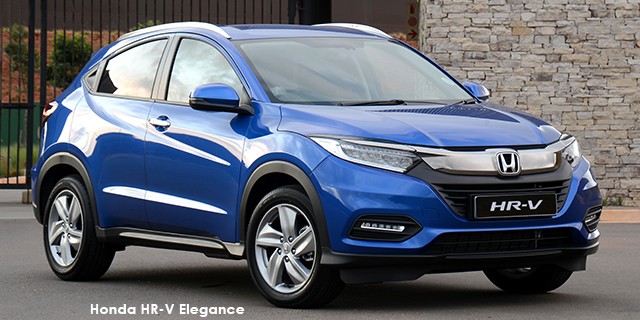Has Honda done enough with the HR-Vs facelift to ensure its midsize crossover keeps its edge in this large market segment?
They offer more for less. That’s why the level of interest in (and, consequently, sales of) midsize crossovers have risen in the past few years. Not only are they more spacious than hatchbacks of the same length and width, but their raised ride heights and elevated seating positions are very appealing.
Honda’s HR-V, which arrived on the local market in 2015, has garnered a notable share of Honda South Africa’s monthly new-vehicle sales. In some months, Honda sells as many units of the HR-V as the Jazz small hatchback, which is surprising given the latter is more affordable and also particularly practical for its size.
The revised HR-V incorporates aesthetic upgrades, plus improvements to the range’s specifications, both of which are part and parcel of product-cycle updates.
From the front, the HR-V features revised headlamps (adorned with LED elements and daytime-running lights on this Elegance model), as well as a mildly reshaped bumper and bonnet. The vehicle’s flanks still incorporate flush and hidden rear door handles, while the 17-inch alloy wheels (wrapped in 215/55 tyres) are of a fresh design and the taillamp clusters have smoky lenses.
The interior has been suitably smartened up, too. The leather seats (specific to this derivative) are comfortable and supportive, while soft-touch materials adorn the upper parts of the door trims and the outer armrests. The stylish divider between the driver and front-passenger seats affords a pair of cupholders and two small storages spaces. Below the centre console (adjacent to the edges of the front footwells), another oddment storage space with a 12 V socket is provided. As it is not easily visible from the outside, it’s a near-ideal space to recharge devices.
The infotainment system, with its 6,8-inch touchscreen display (as in the pre-facelift range, but now also standard on the Comfort model) is an ex-factory unit. It takes a while to become familiar with the system but it does offer Bluetooth connection/streaming, USB and HDMI ports, plus screen-mirroring for smart devices. However, a number of team members found it clunky to use; we would prefer a more modern, integrated unit with contemporary graphics. Below the infotainment screen, the climate-control system’s flush piano-black buttons have a sophisticated feel.
As for the aft accommodation, occupants are afforded decent headroom, an abundance of legroom and an additional 12 V socket. The Magic Seat system remains the HR-V’s strongest trait; it allows the front-passenger seat to fold backwards (to create a bed), while the second-row squab can fold down to create a flat surface or flip up to offer luggage space behind the front seats.
A niggle in the cabin was the trip-computer button, which is an antiquated push stalk sited just below the instrument cluster. It’s irksome because, on many contemporary vehicles, a steering wheel button performs that function.
Apart from the Honda’s spacious and practically configured cabin, its drivetrain combination (a naturally aspirated, 1,8-litre four-cylinder petrol motor mated with a continuously variable transmission) impressed us more than we anticipated. Eager throttle mapping gives the HR-V a brisk nature; progress is not overly dulled by the sensation of elasticity created by many CVTs. What’s more, the Honda never feels ponderous, it handles nimbly and is easy to manoeuvre in most driving situations. Upon selecting reverse, the rear-view camera, which is standard on this model, makes it even easier to park this midsize crossover.
There is admittedly a whine from the drivetrain when you plant the Honda’s throttle pedal but, when you relax your right foot’s input, the revs drop and, at an indicated 120 km/h, the rev needle hovers just above 2 000 r/min, which is a laudable for a 1,8-litre petrol engine. The powerplant is not particularly torquey, however (a middling 172 N.m is available). This means you need to make use of plenty of revs for urgent acceleration but, fortunately, there is the option to utilise the steering-wheel-mounted paddles to override the transmission to access the CVT’s seven “virtual” gears. Plus, the 1,8 Elegance will reward a measured driving style: the test unit consumed 7,10 L/100 km on our fuel route.
Meanwhile, the Honda’s ride quality is commendable: the suspension absorbs road imperfections well and good road-noise suppression is a boon to overall refinement. One tester, who spent a year with the current CR-V, remarked the HR-V’s ride quality compares well with that of its more expensive sibling.
TEST SUMMARY
As a compact family car, the HR-V 1,8 Elegance is easy to recommend; it's a doddle to drive, comfortable and offers almost all of the conveniences you would expect from a vehicle of its price and size. Needless to say, it is a step up compared with the outgoing model, but at the same time the competitors have also improved their game.
The midsize-crossover segment is arguably the most tightly contested in the market. Perhaps the more affordable Comfort version, which costs a significant R65 000 less, is the more prudent pick in the range.
*From the February 2019 issue of CAR magazine
ROAD TEST SCORE

|
Original article from Car











